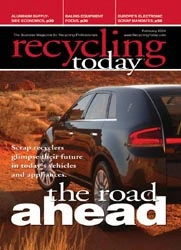Plastics
ORGANIZATIONS SIGN R&D AGREEMENT
The Department of Energy, Argonne National Laboratory, the Vehicle Recycling Partnership of USCAR and the American Plastics Council have signed a five-year, multi-million-dollar, cost-shared Cooperative Research and Development Agreement (CRADA) designed to maximize cost-effective recycling of end-of-life vehicles.
With greater demands for better fuel economy and lower emissions, manufacturers are incorporating increasing amounts of lightweight and nonmetallic materials into vehicles. Nearly 15 million vehicles are shredded for recycling annually. Much of the nonmetallic content in end-of-life vehicles cannot be recycled in light of separating and sorting difficulties and a lack of existing markets and applications for recycled nonmetallics. This shredder residue, comprising about 25 percent of every junked vehicle, must then be landfilled at a significant cost to the vehicle recycler.
Argonne, the APC and USCAR intend to pursue an aggressive research agenda that will focus on the development and demonstration of technologies to recover and recycle automotive materials within the existing recycling infrastructure. The CRADA team will seek cooperation with all key stakeholders.
Mike Fisher, director of technology for the American Plastics Council, says. "The headway we make in boosting vehicle recyclability will be a boon to the American recycling industry, and the American Plastics Council is pleased to be actively involved in the search for optimal, sustainable solutions to the management of end-of-life vehicles."
"This project brings together the APC’s knowledge of polymers and recycling processes, Argonne’s research expertise and USCAR’s understanding of the marketplace," Harvey Drucker, Argonne’s associate laboratory director, says. "Together as a team, we can lead the development of viable solutions to the vehicle recycling challenges of today and the future."
A pilot recycling facility operating at Argonne will serve as a focal point for research that will be conducted by the partners. Argonne’s facility uses a two-stage separation process that begins with bulk separation of all shredder residue into four categories: fines (iron oxides, other oxides, glass and dirt), polyurethane foams, polymers (polypropylene, polyethylene, ABS, nylon, PVC, polyester, etc.) and ferrous and nonferrous metals.
Sponsored Content
Labor that Works
With 25 years of experience, Leadpoint delivers cost-effective workforce solutions tailored to your needs. We handle the recruiting, hiring, training, and onboarding to deliver stable, productive, and safety-focused teams. Our commitment to safety and quality ensures peace of mind with a reliable workforce that helps you achieve your goals.
Sponsored Content
Labor that Works
With 25 years of experience, Leadpoint delivers cost-effective workforce solutions tailored to your needs. We handle the recruiting, hiring, training, and onboarding to deliver stable, productive, and safety-focused teams. Our commitment to safety and quality ensures peace of mind with a reliable workforce that helps you achieve your goals.
Sponsored Content
Labor that Works
With 25 years of experience, Leadpoint delivers cost-effective workforce solutions tailored to your needs. We handle the recruiting, hiring, training, and onboarding to deliver stable, productive, and safety-focused teams. Our commitment to safety and quality ensures peace of mind with a reliable workforce that helps you achieve your goals.
Sponsored Content
Labor that Works
With 25 years of experience, Leadpoint delivers cost-effective workforce solutions tailored to your needs. We handle the recruiting, hiring, training, and onboarding to deliver stable, productive, and safety-focused teams. Our commitment to safety and quality ensures peace of mind with a reliable workforce that helps you achieve your goals.
Sponsored Content
Labor that Works
With 25 years of experience, Leadpoint delivers cost-effective workforce solutions tailored to your needs. We handle the recruiting, hiring, training, and onboarding to deliver stable, productive, and safety-focused teams. Our commitment to safety and quality ensures peace of mind with a reliable workforce that helps you achieve your goals.
Sponsored Content
Labor that Works
With 25 years of experience, Leadpoint delivers cost-effective workforce solutions tailored to your needs. We handle the recruiting, hiring, training, and onboarding to deliver stable, productive, and safety-focused teams. Our commitment to safety and quality ensures peace of mind with a reliable workforce that helps you achieve your goals.
Get curated news on YOUR industry.
Enter your email to receive our newsletters.

Explore the February 2004 Issue
Check out more from this issue and find your next story to read.
Latest from Recycling Today
- Green Cubes unveils forklift battery line
- Rebar association points to trade turmoil
- LumiCup offers single-use plastic alternative
- European project yields recycled-content ABS
- ICM to host colocated events in Shanghai
- Astera runs into NIMBY concerns in Colorado
- ReMA opposes European efforts seeking export restrictions for recyclables
- Fresh Perspective: Raj Bagaria






